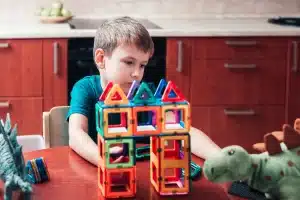The Role of Magnetic Building Toys in STEM Education
STEM education, which focuses on science, technology, engineering, and mathematics, plays a crucial role in preparing students for the future. It fosters the development of critical thinking, problem-solving, and creativity skills. One innovative and engaging tool that has gained popularity in recent years is magnetic building toys. These toys are not only fun to play with but also provide numerous benefits in promoting STEM education among children. Let’s explore the role of magnetic building toys and why they are a smart choice for educators and parents alike.
Features of Magnetic Building Toys:
- Promote hands-on learning: Magnetic building toys allow children to construct various structures and designs using magnetic pieces. This hands-on approach enables them to brainstorm ideas, visualize concepts, and practice problem-solving skills.
- Enhance spatial reasoning skills: The magnetic nature of these toys provides a unique opportunity for children to understand spatial relationships, symmetry, and structural integrity. They can experiment with different arrangements and observe how structures change in response to adjustments.
- Encourage creativity and imagination: By offering endless possibilities, magnetic building toys encourage children to think outside the box and explore their creativity. They can create imaginative stories, build unique structures, and design their own inventions.
- Develop fine motor skills: When children manipulate magnetic pieces, they practice their fine motor skills. The process of picking, placing, and connecting the magnets requires precision and dexterity, which contribute to their physical development.
- Foster collaboration and teamwork: Magnetic building toys can enhance social skills as well. When children work together on a project, they learn how to communicate, share ideas, and collaborate towards a common goal. This teamwork aspect prepares them for future group projects and fosters a sense of camaraderie.
- Introduce basic engineering concepts: Through experimentation, children begin to understand foundational engineering principles such as balance, stability, and force. They can build bridges, towers, and other structures, learning firsthand how these concepts apply.
- Develop critical thinking skills: Magnetic building toys challenge children to think critically, analyze problems, and devise solutions. They must consider factors like weight distribution, magnet strength, and structural stability, which promote logical thinking and problem-solving abilities.
- Promote STEM integration: By engaging children in hands-on play, magnetic building toys seamlessly integrate multiple STEM elements. They combine science through exploration and observation, technology through the use of magnets, engineering through structure construction, and mathematics through calculation and measurement.
- Provide a versatile learning tool: Magnetic building toys can be used across different grade levels and academic subjects. From early years to advanced levels, they offer a versatile platform for learning various concepts, making them suitable for both classrooms and home environments.
In conclusion, magnetic building toys play a vital role in promoting STEM education. Their unique features empower children to explore STEM concepts in a fun and interactive way. By enhancing critical thinking, problem-solving, creativity, and collaboration skills, these toys prepare students for the challenges of the future. Whether in classrooms or at home, magnetic building toys provide valuable learning experiences that help cultivate a lifelong interest in STEM subjects.





